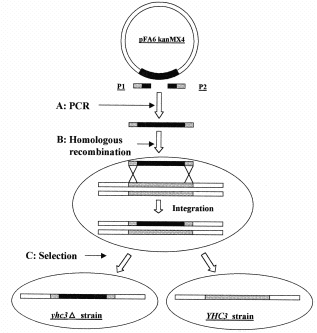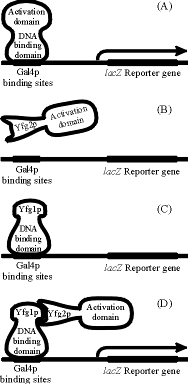Experimental
Techniques
Outlined below are a few laboratory techniques whose discovery was facilitated by the sequencing of the yeast genome.
Yeast
Artificial Chromosomes (YACs)
One of the goals of molecular genetics is to obtain
physical data about the genomic organization of DNA. In order to characterize genomes requires the cloning of
large chromosomal fragments. YAC is
a vector system that allows large segments (between 200 kb and 800 kb) of DNA to
be cloned. These cloning systems
are based on yeast linear plasmids containing three important DNA elements
required for mitotic stability: telomere (TEL), origin of replication (ARS) and
centromere (CEN). Using YAC
vectors, recombinational cloning can be achieved.
Figure of a yeast artificial chromosome cloning system. Reproduced with permission from Fred Sherman. http://dbb.urmc.rochester.edu/labs/sherman_f/yeast/14.html
Genetic
Transformation
Due
to the fact that yeast can transform plasmids, using S. cerevisiae facilitates the introduction of a specific marker into
its genome that is associtated with a novel characteristic or phenotype of
interest. This process, called genetic
transformation, plays a critical role in the manipulation and studying the
behaviour of genes. S.
cerevisiae cells are
converted into transformable spheroplasts, yeast cells with a deficient cell
wall, with treatment by lithium
salts and the use of electroporation.

Sequence
Alignment
Due
to the fact that the entire genome sequence is known, any gene of interest can
be compared to all yeast genes using online tools such as BLAST or FASTA. Similarly, one can find
similar sequences to a particular yeast gene.
During
the comparison, the homology between sequences is calculated using statistical
methods by the computer program and can serve as an indicator of evolutionary
relatedness between the two genes. Sequence alignment serves as an indicator
of the genetic relatedness between the organisms.
Homologous
Recombination
The basis for the construction of genetic maps, which displays the determined traits of a chromosome, is homologous recombination. As a consequence of knowing the genome sequence, researchers can genetically engineer recombinations S. cerevisiae alleles. This process requires several steps including the introduction of strand nicks into each strand followed by strand exchange and sealing of the nicks.
Yeast two-hybrid Systems
This is a powerful experimental tool which can be used to determine if certain proteins can interact with each other and how strong that interaction is. Fusion proteins, which have a protein of interest fused to either the activation or DNA binding domain of a transcriptional enhancer of a reporter gene, are expressed by transforming genetically engineer plamids into yeast cells. If two proteins interact, the activation domain and DNA binding domain of the transcription factor will interact and produced an increase in the level of reporter gene transcribed. Below is a figure reproduced with permission of the author, Dr. F. Sherman that illustrates two protein interacting to bring both domains of Gal4 together to enhance trancription of the lacZ reporter gene..
